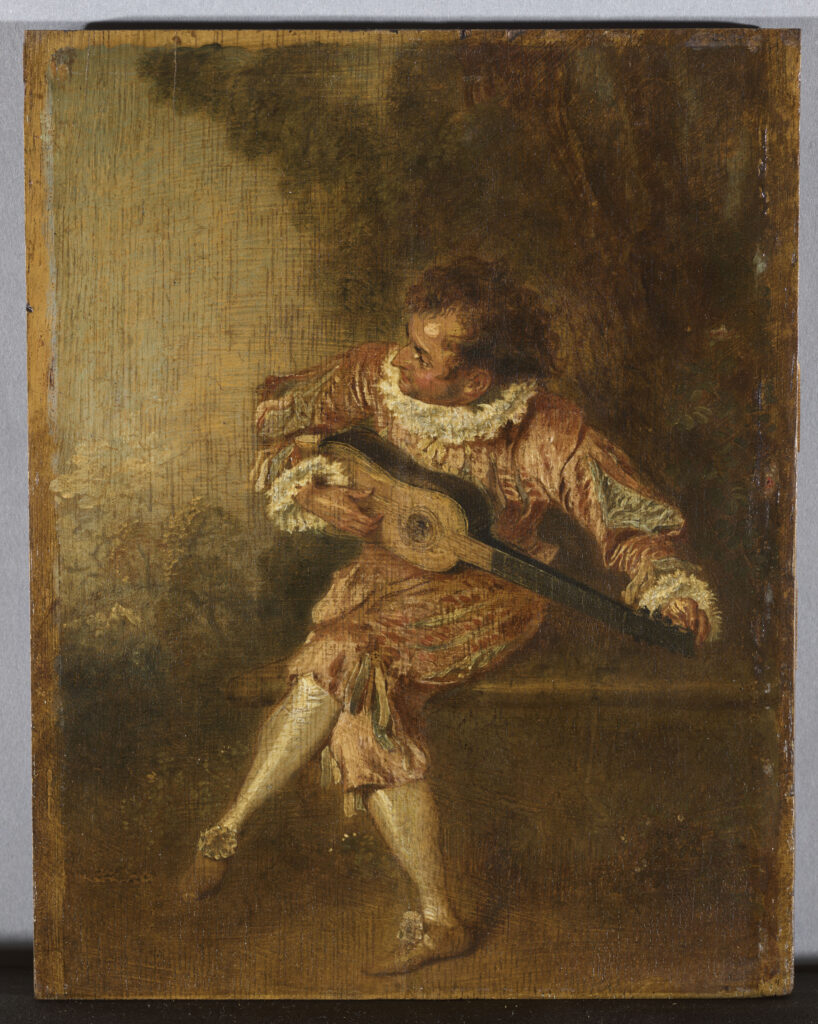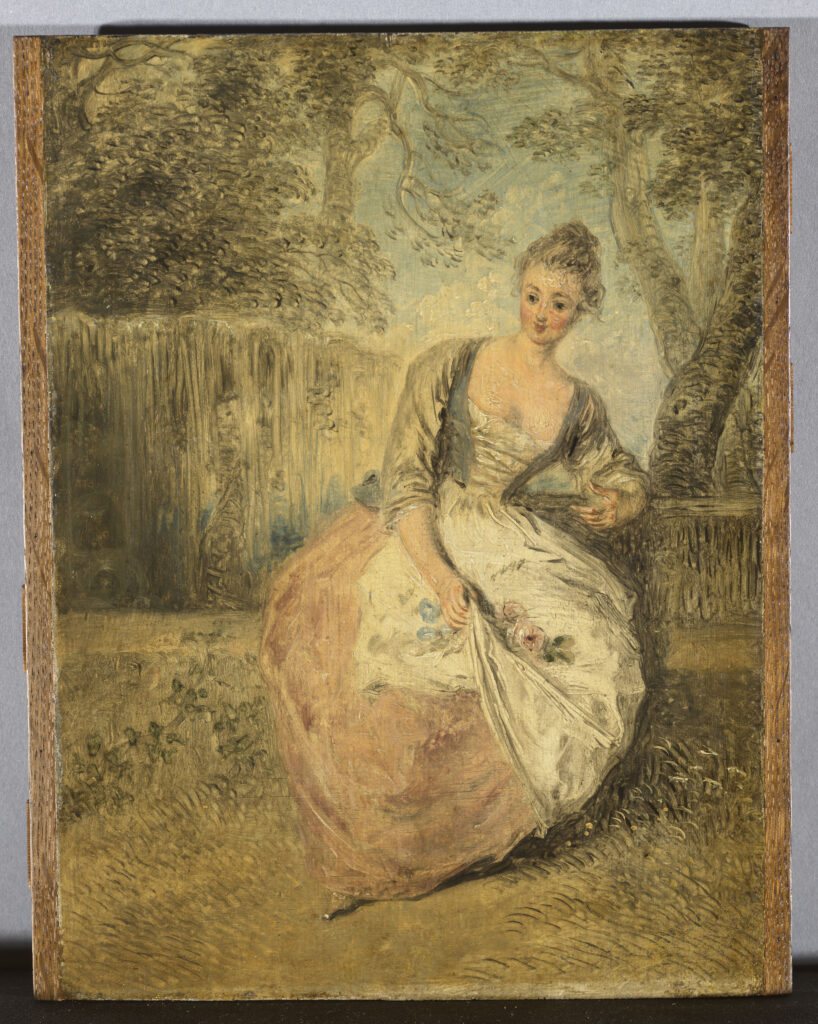Jean-Antoine Watteau (1684–1721) was the most exquisite of Old Masters: he portrayed the melancholy sense that elegant pleasures are fleeting and condemned to fade. No wonder that covers of Mozart albums have been decorated with Watteau’s pictures. The Château de Chantilly’s Musée Condé holds ten Watteaus, France’s largest collection of the artist’s work outside of the Louvre. Its current exhibition “Watteau’s Worlds” presents all four Watteau paintings and six Watteau drawings in the museum’s permanent collection, as well as works lent from other museums and private collections. Several of these, rarely reproduced, come from a private owner in Los Angeles, whose treasures survived the city’s recent fires.
Chantilly’s Watteaus were acquired by the château’s nineteenth-century owner, the Duke of Aumale, who spent much of his life in exile in Twickenham after his father, King Louis-Philippe, abdicated by force in 1848. Watteau, admired during his brief life and just after it, fell into artistic purgatory during the later years of the eighteenth century, when French Roundheads emerged to condemn Cavaliers. Denis Diderot expressed his disapproval of Watteau’s art, dismissing it, along with Boucher’s and Fragonard’s, as too frivolous. Jacques-Louis David taught his students to despise Watteau as indicative of the ancien régime’s aristocratic art. David’s pupils threw bread rolls at Watteau’s Pilgrimage to Cythera (ca. 1718–19),then hanging at the Academy of Painting and Sculpture, and one took his fist to it. “Monsieur Watteau would never have treated your work that way,” a curator chided the barbarians, and he put Watteau’s masterpiece in an attic for safekeeping until friendlier times. Those times came soon after Napoleon’s fall in 1815, and Watteau’s reputation and that of all eighteenth-century art rose slowly and surely throughout the following century.

Watteau, born in Valenciennes, long a part of Flanders but taken by Louis XIV’s armies a few years before the artist’s birth, is best seen as a Flemish painter whose art transformed French paintings. His origins were modest, but his work was suited to the well-born. Described as solitary, he nonetheless made such distinguished friends as the Count of Caylus, who later wrote Watteau’s biography, and the financier and collector Pierre Crozat, who harbored him at the Château de Montmorency. With the tuberculosis that killed him in his thirties, his vagabond life that lacked a fixed address, and the thoughtful, melancholic faces he often portrayed, the artist has been regarded as a prototype of Romanticism. Nevertheless, he was closer in style to his contemporary Alexander Pope than to Keats, as Michael Levey observed in his book Rococo to Revolution (1966). Pope, born in 1688, four years after Watteau, explored and celebrated women in verse just as Watteau did in his art. Watteau was the master of depicting amorous dalliance, with his couples too entranced by one another to take much interest in the outside world. Rarely, however, did Watteau portray physical passion. Couple of Dancers Kissing (whose date is unknown, as with many works in the exhibition), a sketch after Rubens’s La Kermesse (ca. 1635–38), is an exception. Watteau used the same embracing couple in The Surprise (ca. 1718), which also repeats the guitarist in Player of Serenades (ca. 1715, in Chantilly’s permanent collection), who plucks his guitar to encourage the pair. The exhibition places these alongside a drawing of the same figure in Man Playing Guitar (ca. 1715), normally housed in the Louvre’s graphic-arts department.
The exhibition opens with portraits, starting with the famous Portrait of Antoine Watteau in a Wallet, possibly a self-portrait or done by François Boucher or Jean de Jullienne, showing a somber face in a flowing wig. A Boucher watercolor copy, drawn circa 1731, a decade after Watteau’s death, depicts the artist with slightly more pronounced features. Possible glimpses of Watteau here are in two pictures, from Parisian private collections, that are rarely seen or reproduced, the shy-looking drawing Man’s Face, showing wavy, wigless short hair, and the figure in The Country Concert, standing slightly outside the group of joyful musicians with a face of solemn piety. The Seated Woman, Her Head Veiled; Man’s Head (ca. 1718–19) shows two figures deep in thought. Something similar could be said of the figures in The Family, the mother sulky while her husband, holding their infant, gestures at her.

Watteau learned much from studying and copying from earlier masters. He started his Paris career as a copyist on the Pont Notre-Dame before joining the studios of Claude Gillot and Claude Audran III. Audran introduced him to the Palais de Luxembourg, where Watteau discovered Rubens’s Marie de Medici paintings. The painter’s debt to Rubens is well known, but the exhibition shows his version of Rembrandt’s Landscape with a Bear Fighting a Goat (ca. 1650, itself after Titian), to which Watteau added his own distinctive touch in making it clearer that the animal the bear is devouring is a goat. Watteau also learned from Venetian masters. The exhibition shows how Alvise dal Friso’s Venus Disarming Cupid gave Watteau the idea for his painting Love Disarmed (ca. 1715). Watteau’s preparatory drawing, now belonging to the Louvre, and the painting, bought by Aumale in 1868, are united in the exhibition.
Watteau was an acute reporter of the world he saw. The exhibition features illustrations of soldiers he observed at Valenciennes, standing, sitting, drinking, and cleaning their weapons while waiting to be called. The year 1715 was a turning point—it was then he became the complete master of his favored sketching instruments: chalks in red, black, and white. His expertise is exemplified in the circa 1716 drawing of a balding, bearded, gentle-faced pilgrim, bearing a staff on his way to Santiago de Compostela in Spain, and in Standing Savoyard with a Marmot (ca. 1708–16), an example of the many refugees then flooding Paris from the Duchy of Savoy.

No one portrayed necks as skillfully as Watteau, and he is unsurpassed in capturing feminine elegance: The Worried Lover (ca. 1717–20) provides a perfect example. Seated Young Woman Tuning a Theorbo (ca. 1715) is another instance of Watteau’s enjoyment of illustrating musicians, often guitarists, proving with her beguiling appearance that music is the food of love. The exhibition concludes with a room devoted to fêtes galantes, the genre label the French Royal Academy created for Watteau’s paintings when he was admitted in 1717. In fact, these scenes were inspired by the Flemish artistic tradition. In works like The Enchanted Isle, Watteau also adds a more delicate, poetical element, with majestic, Titianesque skies, to the Flemish mix.
At the same time as its look at, the Musée Condé is celebrating in its library the princely flotillas that sailed on its canals and channels when the château belonged to the princes of Condé. The Grand Condé, Louis II of Bourbon, Prince of Condé (1621–86), a military hero, was obliged to retreat to his domains at Chantilly after taking part in the Fronde, a revolt against his cousin Louis XIV. He used the time to develop and embellish his grounds, including its waterworks, making Chantilly a sumptuous but more relaxed alternative to Versailles. His bold invitation of Louis XIV and his court to Chantilly, in 1671, effected a complete reconciliation.
Magnificent paintings and illustrations show the boats that glided on Chantilly’s waters into the eighteenth century. The French Revolution and the nineteenth century initiated an obvious decline in that portion of Chantilly’s heritage, but Claude-Louis Desrais’ Amusement in the Hamlet of Chantilly, or the Shipwreck (late eighteenth century) provides an entertaining look at changing fashions: an early nineteenth-century buck and two belles stand on the water’s edge, while two bewigged survivors, dressed as if from the previous century, paddle their boat away from an up-to-date trio, who slip into the water. This second exhibition gives a rousing coda to a sublime look at Watteau.















